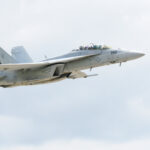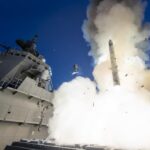Decreased defense spending and a reduced threat environment for helicopters are hampering the ability of non-original equipment manufacturers (OEM) to break into the Defense Department rotorcraft marketplace, according to a defense analyst.Lexington Institute think tank COO Loren Thompson said April 7 the only way for companies without existing DoD business to break into the marketplace is to win new start programs. The Army, he said, simply doesn’t have the money for new starts and existing adversaries aren’t driving an impetus…
Contract Updates
CORRECTION: The contract announced on Sept. 29 2025 (for A-GAS US Inc., Bowling Green) – $31,442,629
CORRECTION: The contract announced on Sept. 29, 2025, for A-GAS US Inc., Bowling Green, Ohio (SPE4A7-25-D-0386) for $31,442,629 was not awarded.
UPDATE: Somo Lens LLC (Santa Fe Springs, California (SPE2DF-26-D-0004) – $37,500,000)
UPDATE: Somo Lens LLC,* Santa Fe Springs, California (SPE2DF-26-D-0004, $37,500,000) has been added as an awardee to the multiple award contract for optical lens program for the Defense Logistics Agency Electronic Catalog, issued against solicitation SPE2DE-24-R-0002 and awarded on May…
UPDATE: Hologic Sales and Service LLC (Marlborough, Massachusetts (SPE2D1-26-D-0005) – $95,000,000),
UPDATE: Hologic Sales and Service LLC, Marlborough, Massachusetts (SPE2D1-26-D-0005, $95,000,000), has been added as an awardee to the multiple award contract for medical equipment and accessories for the Defense Logistics Agency Electronic Catalog, issued against solicitation SPE2DH-21-R-0002 and awarded Feb.…
Vertex Aerospace LLC (Madison, Mississippi) – $
Vertex Aerospace LLC, Madison, Mississippi, was awarded an undefinitized contract action with a not-to-exceed price of $ 20,995,905 for F-16 Systems Program Office Foreign Military Sales (FMS) support. This contract action involves FMS support for contractor logistics support (CLS) for…
Lack Of Funding, New Starts Plaguing DoD Rotorcraft Procurement Competition
Decreased defense spending and a reduced threat environment for helicopters are hampering the ability of non-original equipment manufacturers (OEM) to break into the Defense Department rotorcraft marketplace, according to a defense analyst.
Lexington Institute think tank COO Loren Thompson said April 7 the only way for companies without existing DoD business to break into the marketplace is to win new start programs. The Army, he said, simply doesn’t have the money for new starts and existing adversaries aren’t driving an impetus for advanced rotorcraft capabilities.
Thompson doesn’t foresee any new start programs arising over the next five-to-10 years, meaning Sikorsky, a division of Lockheed Martin [LMT], will maintain dominance over the U.S. military rotorcraft marketplaces for years to come. This leaves potential competitors like Airbus, Bell Helicopter Textron [TXT], Boeing [BA] and Finmeccanica’s AgustaWestland unable to add new DoD business, though many of them already have established DoD programs.
“It would be nearly impossible for anyone other than the OEM to do an upgrade to a military helicopter,” Thompson said. “It really has to be a clean sheet for outsiders to get into the business.”
DoD has spent millions upon millions of dollars trying, and failing, to fulfill a number of new starts over the years, ranging from the Air Force’s Combat Search and Rescue Helicopter (CSAR-X) to the Army’s Armed Aerial Scout (AAS) and Armed Reconnaissance Helicopter (ARH). Thompson said CSAR-X was poised to add another Boeing aircraft into the fold. Boeing already provides its AH-64 Apaches to the Army.
Sikorsky was the only bidder in a pair of big Defense Department rotorcraft procurements in the last five years. It was awarded an initial $1.3 billion contract for Air Force’s Combat Rescue Helicopter (CRH) in 2014 and also received an initial $1.2 billion award for the Navy’s beleaguered presidential helicopter replacement, or VXX. Competitors said they didn’t bid because the competition favored another bidder.
The Army and Navy, together, awarded Sikorsky an $8.5 billion contract in 2012 to buy a baseline quantity of 653 Black Hawk and Sea Hawk helicopters. A Sikorsky statement at the time said this was the eighth multi-year order of H-60 helicopters since 1982. Sikorsky was acquired from United Technologies Corp. [UTX] in late 2015.
The last time DoD had a real competition was in 2005 when Airbus, formerly known as EADS North America, offered its UH-72A Lakota and beat out Bell Helicopter Textron, MD Helicopters and AgustaWestland to win the Army’s Light Utility Helicopter program in June 2006. Bell offered its 210 and Twin Huey, MD bid its MD900 while AugustaWestland pitched its AW139.
During the tail end of the Cold War, the Army had a major rotorcraft competition called Light Helicopter Experimental (LHX). A Boeing-Sikorsky team ultimately won the hard fought competition in 1991, but the program, later renamed Comanche, was canceled in 2004. It failed to produce any operational helicopters.
Thompson defines a new start program as a new start of requirements for which a new design has to be created that leads to a development program. Many of DoD’s existing rotorcraft programs have been modernizations or replacement programs, rather than brand new programs.
AIR FORCE TRIES AGAIN
Fast forward to today. Another DoD service has identified a helicopter fleet it needs to urgently recapitalize and, once again, it looks like a contract could be awarded without competition.
The Air Force wants to improve the capability currently being filled by its UH-1N helicopters and it especially wants to quickly replace those helicopters that perform the nuclear mission. Assistant Secretary for Acquisition Lt. Gen. Arnold Bunch said at a Washington industry conference in March the service wanted to use an Economy Act declaration & finding (D&F) to procure roughly 41 new aircraft to fulfill the nuclear mission.
An Economy Act D&F, while not a sole source award, bypasses a procurement competition by piggybacking an existing Defense Department contract. Bunch told a House panel in March the Air Force could spend between $800 and $900 million to replace the nuclear mission UH-1Ns, which is developed by Bell Helicopter Textron and deployed in 1970. It performs a variety of missions, generally split between the nuclear mission and other duties. These include airlift of emergency security forces, security and surveillance of off-base nuclear weapons convoys and distinguished visitor airlift.
Some lawmakers are encouraging the Air Force to sole source the UH-1N replacement nuclear mission helicopters. Thirteen House lawmakers wrote leadership in the House Armed Services Committee (HASC) and House Appropriations defense subcommittee (HAC-D) in late February, urging them to include language in their upcoming fiscal year 2017 bills directing the Air Force to purchase UH-60M Black Hawk helicopters from the Army’s current block buy grant. The UH-60M is a two-engine aircraft with max cruise speed of 151 knots and 276 nautical miles max range with no reserve.
PERSPECTIVES DIFFER
Sources who spoke with sister publication Defense Daily were split on whether DoD’s habit of awarding rotorcraft contracts without competition was bad for the military. A lobbyist who represents competing aircraft manufacturers argued that sole sourcing these contracts not only inflates the true price tag DoD pays for aircraft, but also reduces their maximum potential capability. Companies, he argued, invest tens of millions of dollars to ramp up capabilities and prepare for an Air Force UH-1N competition, only to be rewarded with service leaders saying publicly they were thinking of awarding the contract without competition.
Thompson, the defense analyst, argued that competitions can waste money and that sole sourcing the UH-1N contract to Sikorsky would save the Air Force money in the long run. Thompson, whose think tank Lockheed Martin contributes to, said the Air Force can tell Sikorsky that, without a good price, it can’t award the UH-1N contract at all. Secondly, Thompson said, since the Black Hawk is already in the joint force, sustainment costs would be lower than if the Air Force introduced another aircraft variant into the field.
Retired Air Force Lt. Gen. James Kowalski, former head of Air Force Global Strike Command (AFGSC) and deputy commander of U.S. Strategic Command (USSSTRATCOM), told sister publication Defense Daily on April 7 he believed the Economy Act D&T was the smartest way for the Air Force to procure UH-1N replacements. He said the Air Force has faced funding challenges in replacing the aircraft throughout the years and there aren’t many companies building the properly sized helicopter to do the mission the way it is currently defined.
Kowalski said a replacement helicopter remains an urgent need since a number of DoD-directed requirements changed, without funding, in a response to 9/11. He said the number of airmen required to fit in the aircraft became larger than the UH-1N could accommodate. Kowalski also said the current Hueys don’t have the range to cover distances required at some of the furthest ICBM site locations, which are scattered across vast distances in Montana, Wyoming and North Dakota. He also said they don’t have the speed to meet mission requirements.
Steven Schooner, professor of government procurement law at the George Washington University Law School and a retired Army Reserve officer, said there is “no question” that if the Air Force piggybacks on an existing contract for an aircraft they want, and they know that aircraft will fulfill a specific requirement, it reduces their transaction costs. But Schooner said on a macro level, the entire procurement system is based on competition.
“If they’ve lost one or two of them in the last year and they want to replace one or two, there seems to be a fair amount of logic in picking them up off of someone’s vehicle,” Schooner said. “If you tell me you are replacing all of them, even if you are buying, whether a half dozen or 40, I think the argument is going to be very difficult that the best thing to do is piggyback on (another contract).”
Air Force Deputy Chief of Staff for Strategic Plans and Requirements Lt. Gen. Mike Holmes said April 7 the service had not decided on an acquisition strategy and was working with Congress on the proper way forward. Air Force spokesman Maj. Robert Leese said April 8 that the service is currently focused on the “urgent” operational needs of the ICBM mission set and that a separate acquisition strategy for the other UH-1N missions, like VIP and continuity of government missions, will be developed at a later date.
More details should emerge on the future of the UH-1N procurement when the House and Senate mark up their versions of the fiscal year 2017 defense authorization bills. The HASC subcommittees mark up their bills in open sessions the week of April 18 while the full committee holds its markup on April 27. Most SASC subcommittees will mark up their bills in closed sessions on May 9-10 while the full committee holds its markup starting May 11, also in a closed session.
Contract Updates
CORRECTION: The contract announced on Sept. 29 2025 (for A-GAS US Inc., Bowling Green) – $31,442,629
CORRECTION: The contract announced on Sept. 29, 2025, for A-GAS US Inc., Bowling Green, Ohio (SPE4A7-25-D-0386) for $31,442,629 was not awarded.
UPDATE: Somo Lens LLC (Santa Fe Springs, California (SPE2DF-26-D-0004) – $37,500,000)
UPDATE: Somo Lens LLC,* Santa Fe Springs, California (SPE2DF-26-D-0004, $37,500,000) has been added as an awardee to the multiple award contract for optical lens program for the Defense Logistics Agency Electronic Catalog, issued against solicitation SPE2DE-24-R-0002 and awarded on May…
UPDATE: Hologic Sales and Service LLC (Marlborough, Massachusetts (SPE2D1-26-D-0005) – $95,000,000),
UPDATE: Hologic Sales and Service LLC, Marlborough, Massachusetts (SPE2D1-26-D-0005, $95,000,000), has been added as an awardee to the multiple award contract for medical equipment and accessories for the Defense Logistics Agency Electronic Catalog, issued against solicitation SPE2DH-21-R-0002 and awarded Feb.…
Vertex Aerospace LLC (Madison, Mississippi) – $
Vertex Aerospace LLC, Madison, Mississippi, was awarded an undefinitized contract action with a not-to-exceed price of $ 20,995,905 for F-16 Systems Program Office Foreign Military Sales (FMS) support. This contract action involves FMS support for contractor logistics support (CLS) for…

 By
By 
















